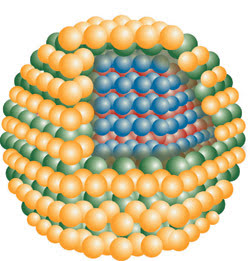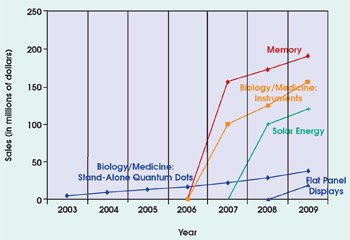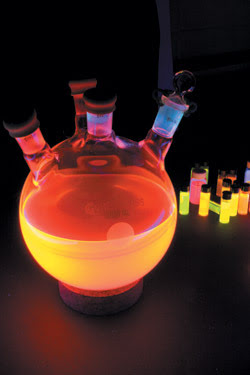Advances in wet chemistry are enabling quantum dots to make inroads into more applications.
Nadya Anscombe, Contributing Editor
Imagine a mechanical part that can tell when it is worn out. Or an ink that is impossible to counterfeit. Or an infrared paint that can help to distinguish friends from enemies using night-vision equipment.
These seemingly unconnected applications all are enabled by the use of quantum dots, nanocrystals of semiconductor material with tunable optical properties. Because of recent advances in the manufacturing technology used to produce the dots, the market for the dots seems poised to explode.

Quantum dots are semiconductor particles that are so small — with diameters typically less than 30 nm — that their energies are determined by their size. Courtesy of Evident Technologies.
Companies now can make larger quantities of quantum dots using wet chemistry rather than traditional semiconductor processes such as molecular beam epitaxy or chemical vapor deposition. Called colloidal nanocrystals, the materials are supplied in a liquid suspension or dispersed in plastic composite form. They can be processed from organic or aqueous solution onto substrates that are rigid or flexible, smooth or rough, flat or curved, inorganic or organic.
As a result of this adaptability, the quantum dot market is experiencing growth. Among the first-generation products emerging today are quantum dot bioconjugates, which in two years have already made an impact in the life sciences and biomedical areas. Market research company Business Communications Co. Inc. of Norwalk, Conn., estimates current sales of quantum dots to be worth $10 million. By 2009, it forecasts that the market will be approximately $550 million.
“Unquestionably, interest in the applications of commercially available colloidal quantum dots has been spurred on by the biological and life science research communities,” said John Oliver, a free-lance market analyst and author of the report. He identified several nonbiological sectors, however, in which quantum dots promise to improve existing technologies. Those that are nearing commercial application include quantum cryptography systems, flash memory, photovoltaics, flat panel displays, flexible organic electronics and white LEDs.

The market for quantum dots is forecast to expand to approximately $550 million by 2009 as the structures find a place in various applications.
Not all of these applications will make it to market at the same time. Oliver predicts that the next big application for quantum dots will be flash memory, followed a year later by third-generation solar cells and then flat panel displays, flexible electronics and telecommunications products. Much of this is dependent on the technical foundation on which the application can draw.
“In most cases, quantum dot-based technologies still have a long learning curve,” he explained. “In particular, their lifetime performance robustness still remains to be proven.”
For example, quantum dot-based white LEDs are very much in their technical infancy. In contrast, flash memory using the dots is close to commercial launch because it is based on an established solid-state platform that is compatible with conventional semiconductor fabrication techniques.
Colloidal dots
With such capital investment in molecular beam epitaxy and chemical vapor deposition equipment, many of the large semiconductor manufacturers are looking at developing products that contain quantum dots. In contrast to this solid-state manufacturing process, colloidal quantum dots are amenable to a much broader audience that does not have access to expensive cleanroom tools. They are made by growing nanocrystals on nucleation sites in a beaker, resulting in a suspension that can be processed in many ways.
One of the largest producers of colloidal quantum dots is Evident Technologies Inc. of Troy, N.Y. The company, which started by developing dot-based products for the telecommunications industry, is working on a variety of applications for quantum dots, including solar cells, anticounterfeiting products, inks and electroluminescent devices.

The unique properties of quantum dots include size-dependent photoemission behavior. By varying their size and shape, they can be made to emitradiation from the ultraviolet to theinfrared. Courtesy of Evident Technologies Inc.
“The biggest challenge for us is understanding the market,” said CEO Clinton Ballinger. “Quantum dots can be used for so many applications in so many markets that all our customers are very different.”
The company recently formed a collaborative research project with Konarka Technologies Inc. of Lowell, Mass., to increase the sensitivity of plastic solar cells to a wider range of the spectrum. “Our quantum dots are tuned to absorb light over the solar spectrum from the visible through the infrared,” Ballinger said. “This leads to harvesting a greater portion of energy, resulting in greater efficiencies for solar cells.”
Solar cells are predicted to be one of the next major applications for quantum dots, but Evident has other customers developing novel products to be released sooner. “We are currently working with a customer to bring to market a mechanical device that can indicate when it needs to be replaced,” Ballinger said.
That device is a load tap changer, which adjusts the output voltage of a transformer so that it is maintained within a certain tolerance. Over time, standard contacts erode and need to be replaced. Researchers at Nichols Applied Technology in Dallas and the Electric Power Research Institute in Palo Alto, Calif., have developed contacts that are implanted with quantum dots.
John Pruente, general manager of High Voltage Supply in Dallas, which manufactures the implantable contacts, explained that when the contact erodes to the point that it should be replaced, a cavity containing quantum dots is breached. The dots are released into the surrounding insulating oil and are detected with a photospectrometer under ultraviolet irradiation. This can be done without interrupting service and without a visual inspection, which was the only way of evaluating wear in the past.
Beyond telecom
A load tap changer is very far removed from telecommunications. Although the telecom industry initially created the demand for quantum dots, that market is not ready at this point for products based on the dots. Ballinger said that the industry simply does not yet require a “displacement technology.”
“We wanted to develop products for femtosecond all-optical switching, but there is simply not demand yet for this,” he said.
Yet there clearly is demand for many other products containing quantum dots. Business Communications predicts exponential growth over the next few years — big news for the small structures.
What Is a Quantum Dot?
Also called a nanocrystal, an artificial atom or a quantum bit, a quantum dot is a particle of material so small that its energies are determined by its size: typically less than 30 nm in diameter (see “Let’s Get Small,” Photonics Spectra, July 2001, page 102). Quantum dots can be made from semiconductors as well as from conductors, and they exhibit unique quantum confinement behavior, a property distinct from their characteristics in bulk form.
An example of this sort of behavior is the size-dependent photoemission of colloidal dispersions of semiconductor particles such as cadmium selenide or similar metal chalcogenides. In these quantum dots, the emission is determined by both their shape and size. Upon photoexcitation, smaller particles tend to emit higher-energy (shorter wavelength) radiation, and larger particles emit lower-energy (longer wavelength) radiation.
Quantum dots can be made to emit from the ultraviolet to the infrared and also have several electronics applications. For example, in quantum computing, a single quantum dot could represent a byte of data or could be used in more than one computational instruction at a time. Other nonoptical applications include nanomachines, neural networks, and high-density memory or storage media.